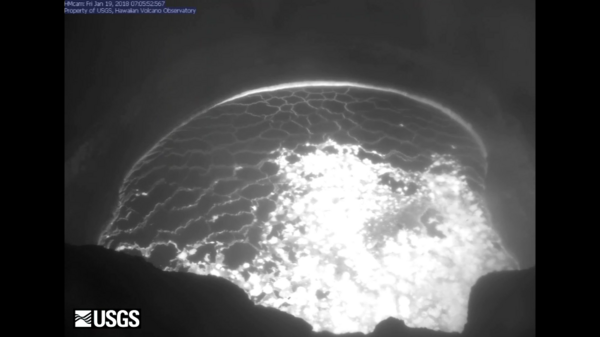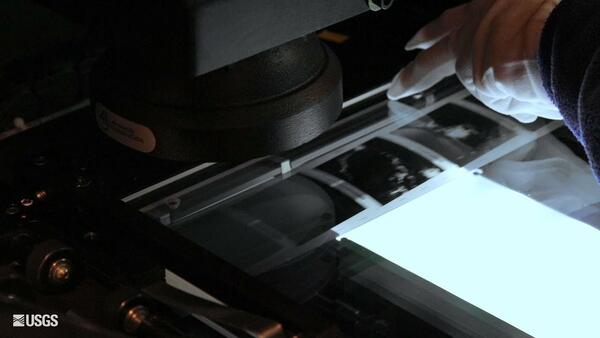A team of USGS geologists provide science support following Montecito post-fire debris-flow event.
Videos
The USGS is a science organization that provides impartial information on the health of our ecosystems and environment, the natural hazards that threaten us, the natural resources we rely on, the impacts of climate and land-use change, and the core science systems that help us provide timely, relevant, and useable information.
 USGS Joins Efforts in Montecito to Assess Debris-Flow Aftermath
USGS Joins Efforts in Montecito to Assess Debris-Flow Aftermath
A team of USGS geologists provide science support following Montecito post-fire debris-flow event.
 PubTalk 1/2018 — ShakeAlert: Path to West Coast EQ Early Warning
PubTalk 1/2018 — ShakeAlert: Path to West Coast EQ Early Warning
Title: ShakeAlert: The Path to West Coast Earthquake Early Warning ... how a few seconds can save lives and property
Title: ShakeAlert: The Path to West Coast Earthquake Early Warning ... how a few seconds can save lives and property
Welcome to the USGS GeoLog Locator, an online tool for viewing and downloading digital borehole geophysical logs. These borehole logs are used to answer scientific questions about things like groundwater availability, geologic structure of the Earth, and certain characteristics of the structure of the soil and rock formations.
Welcome to the USGS GeoLog Locator, an online tool for viewing and downloading digital borehole geophysical logs. These borehole logs are used to answer scientific questions about things like groundwater availability, geologic structure of the Earth, and certain characteristics of the structure of the soil and rock formations.
 Landsat in Action - Free & Open Landsat Archive with Barbara Ryan
Landsat in Action - Free & Open Landsat Archive with Barbara Ryan
Barbara Ryan, Director of GEO talks about the distribution of Landsat data, starting in 1972, and ultimately transitioning to the free and open policy of today.
Barbara Ryan, Director of GEO talks about the distribution of Landsat data, starting in 1972, and ultimately transitioning to the free and open policy of today.
 Rockfalls trigger explosions in Kīlauea Volcano's summit lava lake
Rockfalls trigger explosions in Kīlauea Volcano's summit lava lake
This video shows a rockfall and subsequent explosion that occurred at 7:03 a.m. HST today within the "Overlook crater" at the summit of Kīlauea. This collapse was followed by a smaller rockfall at 7:07 a.m. (not shown in video).
This video shows a rockfall and subsequent explosion that occurred at 7:03 a.m. HST today within the "Overlook crater" at the summit of Kīlauea. This collapse was followed by a smaller rockfall at 7:07 a.m. (not shown in video).
Antarctica's Pine Island Glacier has calved another iceberg. These Landsat images show the progression since just before the break in September until now.
At the USGS EROS Center, we study land change, operate the Landsat satellites, and maintain the longest, continuously acquired collection of images of the Earth's land surface.
Antarctica's Pine Island Glacier has calved another iceberg. These Landsat images show the progression since just before the break in September until now.
At the USGS EROS Center, we study land change, operate the Landsat satellites, and maintain the longest, continuously acquired collection of images of the Earth's land surface.
 Landsat in Action - Monitoring Canada's Forest with Mike Wulder
Landsat in Action - Monitoring Canada's Forest with Mike Wulder
Mike Wulder with Canada's Forest Service talks about the value Landsat images have for mapping and monitoring Canada's forested areas.
Mike Wulder with Canada's Forest Service talks about the value Landsat images have for mapping and monitoring Canada's forested areas.
 Landsat in Action - Tracking Water Changes with John Schott
Landsat in Action - Tracking Water Changes with John Schott
John Schott with the Rochester Institute of Technology discusses using Landsat Data over the years, and how its Thermal data tracks temperature changes in water bodies.
John Schott with the Rochester Institute of Technology discusses using Landsat Data over the years, and how its Thermal data tracks temperature changes in water bodies.
 Image of the Week - Southern California Wildfires Update
Image of the Week - Southern California Wildfires Update
After a month, the wildfires of Southern California are nearly contained. Landsat 8 imagery shows the dramatic burn scars left behind.
At the USGS EROS Center, we study land change, operate the Landsat satellites, and maintain the longest, continuously acquired collection of images of the Earth's land surface.
After a month, the wildfires of Southern California are nearly contained. Landsat 8 imagery shows the dramatic burn scars left behind.
At the USGS EROS Center, we study land change, operate the Landsat satellites, and maintain the longest, continuously acquired collection of images of the Earth's land surface.
James Wamboldt (USGS – La Crosse, WI), Kelsie Murchy (University of Victoria - BC Canada), and Doug Blodgett (The Nature Conservancy- Illinois Rivers Office at Emiquon) testing an underwater acoustic deterrent for Asian Carp at the water control structure located at The Nature Conservancy’s Emiquon Preserve, Lewiston, Illinois in 2017.
James Wamboldt (USGS – La Crosse, WI), Kelsie Murchy (University of Victoria - BC Canada), and Doug Blodgett (The Nature Conservancy- Illinois Rivers Office at Emiquon) testing an underwater acoustic deterrent for Asian Carp at the water control structure located at The Nature Conservancy’s Emiquon Preserve, Lewiston, Illinois in 2017.
 Getting Started with MODIS Version 6 Therm. Anom. & Fire Data Part 1
Getting Started with MODIS Version 6 Therm. Anom. & Fire Data Part 1
This video focuses on the National Aeronautics and Space Administration’s (NASA) Terra and Aqua Moderate Resolution Imaging Spectroradiometer (MODIS) Version 6 Thermal Anomalies and Fire data distributed by NASA’s Land Processes Distributed Active Archive Center (LP DAAC).
This video focuses on the National Aeronautics and Space Administration’s (NASA) Terra and Aqua Moderate Resolution Imaging Spectroradiometer (MODIS) Version 6 Thermal Anomalies and Fire data distributed by NASA’s Land Processes Distributed Active Archive Center (LP DAAC).
 Getting Started with MODIS Version 6 Therm. Anom. & Fire Data Part 3
Getting Started with MODIS Version 6 Therm. Anom. & Fire Data Part 3
This video focuses on the National Aeronautics and Space Administration’s (NASA) Terra and Aqua Moderate Resolution Imaging Spectroradiometer (MODIS) Version 6 Thermal Anomalies and Fire data distributed by NASA’s Land Processes Distributed Active Archive Center (LP DAAC).
This video focuses on the National Aeronautics and Space Administration’s (NASA) Terra and Aqua Moderate Resolution Imaging Spectroradiometer (MODIS) Version 6 Thermal Anomalies and Fire data distributed by NASA’s Land Processes Distributed Active Archive Center (LP DAAC).
 Getting Started with MODIS Version 6 Therm. Anom. and Fire Data Part 2
Getting Started with MODIS Version 6 Therm. Anom. and Fire Data Part 2
This video focuses on the National Aeronautics and Space Administration’s (NASA) Terra and Aqua Moderate Resolution Imaging Spectroradiometer (MODIS) Version 6 Thermal Anomalies and Fire data distributed by NASA’s Land Processes Distributed Active Archive Center (LP DAAC).
This video focuses on the National Aeronautics and Space Administration’s (NASA) Terra and Aqua Moderate Resolution Imaging Spectroradiometer (MODIS) Version 6 Thermal Anomalies and Fire data distributed by NASA’s Land Processes Distributed Active Archive Center (LP DAAC).
USGS scientists, along with collaborators from the Marine Biological Laboratory, deployed a carbon flux tower on Great Marsh in 2017. Great Marsh is a 3800 acre salt marsh complex behind the Sandy Neck barrier beach in Barnstable, Cape Cod. This ecosystem is home to a variety of animals, including deer, fox, owls, and the rare Diamondback terrapin.
USGS scientists, along with collaborators from the Marine Biological Laboratory, deployed a carbon flux tower on Great Marsh in 2017. Great Marsh is a 3800 acre salt marsh complex behind the Sandy Neck barrier beach in Barnstable, Cape Cod. This ecosystem is home to a variety of animals, including deer, fox, owls, and the rare Diamondback terrapin.
 Groundwater use from the Ozark Plateaus aquifer system, 1900 to 2010
Groundwater use from the Ozark Plateaus aquifer system, 1900 to 2010
Groundwater use from the Ozark Plateaus aquifer system, 1900 to 2010” is a short video showing modeled groundwater withdrawal rates from the Ozark Plateaus aquifer system (Ozark system) in the central United States.
Groundwater use from the Ozark Plateaus aquifer system, 1900 to 2010” is a short video showing modeled groundwater withdrawal rates from the Ozark Plateaus aquifer system (Ozark system) in the central United States.
 Kīlauea Summit Eruption | Lava Returns to Halemaʻumaʻu
Kīlauea Summit Eruption | Lava Returns to Halemaʻumaʻu
In March 2008, a new volcanic vent opened within Halema‘uma‘u, a crater at the summit of Kīlauea Volcano in Hawaiʻi Volcanoes National Park on the Island of Hawaiʻi. This new vent is one of two ongoing eruptions on the volcano. The other is on Kīlauea’s East Rift Zone, where vents have been erupting nearly nonstop since 1983.
In March 2008, a new volcanic vent opened within Halema‘uma‘u, a crater at the summit of Kīlauea Volcano in Hawaiʻi Volcanoes National Park on the Island of Hawaiʻi. This new vent is one of two ongoing eruptions on the volcano. The other is on Kīlauea’s East Rift Zone, where vents have been erupting nearly nonstop since 1983.
Landsat Collections: Providing a Stable Environmental Record for Time Series Analysis
Landsat Collections: Providing a Stable Environmental Record for Time Series Analysis
Seismometers record vibrations from a wide assortment of ground motion events. Each event type has a distinctive ground-motion signal with unique frequency and amplitude—its own seismic signature. Seismologists are trained to identify the source of seismic events seen on a webicorder based on its ‘seismic signature’.
Seismometers record vibrations from a wide assortment of ground motion events. Each event type has a distinctive ground-motion signal with unique frequency and amplitude—its own seismic signature. Seismologists are trained to identify the source of seismic events seen on a webicorder based on its ‘seismic signature’.
 MODIS Observes Snowpack in the Sierra Nevada Mountain Range
MODIS Observes Snowpack in the Sierra Nevada Mountain Range
The Moderate Resolution Imaging Spectroradiometer (MODIS) sensor is located onboard NASA’s Terra and Aqua satellites. MODIS data are crucial tools for studying changes that have occurred on the surface of the Earth, including during times of drought.
The Moderate Resolution Imaging Spectroradiometer (MODIS) sensor is located onboard NASA’s Terra and Aqua satellites. MODIS data are crucial tools for studying changes that have occurred on the surface of the Earth, including during times of drought.
 USGS Scenario Evaluator for Electrical Resistivity Survey Design Tool
USGS Scenario Evaluator for Electrical Resistivity Survey Design Tool
This video provides an overvew of the USGS Scenario Evaluator for Electrical Resistivity (SEER).
This video provides an overvew of the USGS Scenario Evaluator for Electrical Resistivity (SEER).
Breakouts remain active on the coastal plain, near the base of the pali. This pāhoehoe breakout was pouring into a small crack when HVO geologists encountered It this afternoon.
Breakouts remain active on the coastal plain, near the base of the pali. This pāhoehoe breakout was pouring into a small crack when HVO geologists encountered It this afternoon.











